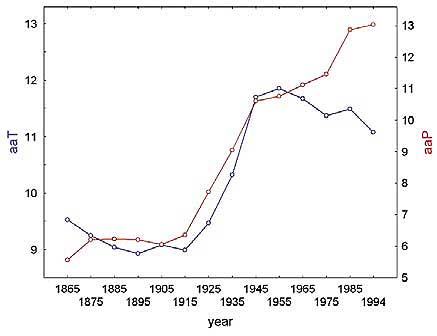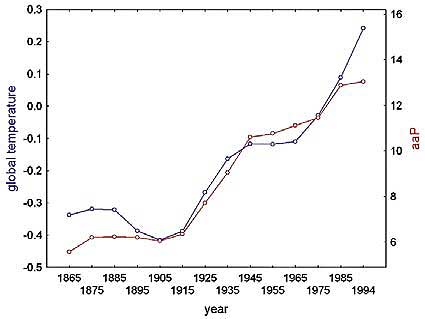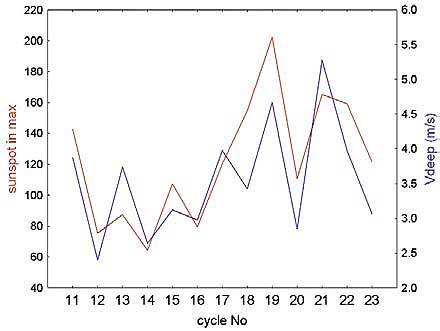In the solar minimum the magnetic field of the Sun resembles the field of a magnetic dipole, with magnetic field lines in north-south direction. Differential rotation (fastest at the equator and decreasing toward the poles) stretches the magnetic field lines at the base of the solar convection zone (~0.7 solar radii) giving rise to the east-west, or toroidal field component. The magnetic field lines emerge, piercing the solar surface in two spots observed as sunspots. Due to the Coriolis force, the leading (in the direction of solar rotation) sunspot which has the polarity of the respective pole, is closer to the equator than the trailing spot with the opposite polarity.
With the progress of the solar cycle, sunspots appear at lower heliolatitudes and the leading sunspots of both hemisphere diffuse across the equator and cancel each other. The rest of the sunspots first cancel the old poloidal field and then accumulate to create the poloidal field of the new cycle with the opposite polarity.
The toroidal field which is proportional to the number of sunspots, determines the electromagnetic radiation emitted from the Sun, solar flares and coronal mass ejections, and the poloidal field is related to the high speed solar wind reaching the Earth. The two are not independent because they are both manifestations of the solar magnetic activity, but their long-term variations are not identical. Different are also their effects on the geomagnetic activity, magnetosphere, ionosphere, upper and lower atmosphere.

Long-term variations of toroidal (blue line) and poloidal (red line) solar magnetic field, climatic norms (30-year moving averages with a step of 10 years, e.g. 1901-1911, 1911-1930, etc.). Credit: Bulgarian Academy of Science
The total solar irradiance determines the total energy received from the Sun. Its variations in the 11-year sunspot cycle are much too small to account for the observed climate change, but much larger variations are found in the UV part of the solar spectrum which doesn’t reach the Earth’s surface but is entirely absorbed in the stratosphere and determines the ozone content and temperature, influences the dynamics of the stratosphere and through it, the dynamics of the troposphere, and therefore weather and climate.
The solar wind effects are through modulation of the cosmic rays flux which affects stratospheric ozone and small constituents, aerosol ionization and the therefore the absorbed solar radiation, the global electric circuit, the distribution of surface pressure and atmospheric circulation. Long-term variations in global temperature correlate better with the variations in the solar poloidal magnetic field.

Long-term variations of global surface air temperature (blue line) and non-sunspot-related solar activity(red line), climatic norms. Credit: Bulgarian Academy of Science
An important element of solar dynamo is the large-scale solar meridional circulation which carries the magnetic field poleward on the surface to create the poloidal field of the next cycle, and equatorward in depth to generate the toroidal field of the next sunspot maximum. The relation of the speed of the surface and deep circulation with the amplitude of the solar poloidal and toroidal magnetic field determines the regime of operation of the solar dynamo and allows for the forecast of future solar activity. However, direct measurements of the surface circulation are only available for a little more than one sunspot cycle, while deep circulation cannot be measured yet.
A method has been developed by the Solar-Terrestrial Influences Institute at the Bulgarian Academy of Sciences for estimation of the long-term variations of the speed of the surface and deep meridional solar circulation based on geomagnetic data. It is found that in “normal” regime a faster deep circulation leads to a higher sunspot maximum, while in periods of secular solar minimum, the relation is reversed.

Amplitude of the sunspot maximum in consecutive sunspot cycles (red line) and the speed of the deep meridional circulation preceding this sunspot maximum (blue line). Credit: Bulgarian Academy of Science
Further, the regime of operation of the solar dynamo is determined by the average diffusivities in the solar convection zone layers involved in surface and deep circulation, which depends on the ratio of the speeds of the surface and deep circulations, and is related to the different long-term evolution of the solar poloidal and toroidal fields. Based on the expected speeds it is forecasted that the Sun is entering a prolonged period of low solar activity which will lead to a decrease in the global surface temperature of the Earth. This conclusion is in agreement with solar activity forecasts derived by different methods.





Comments